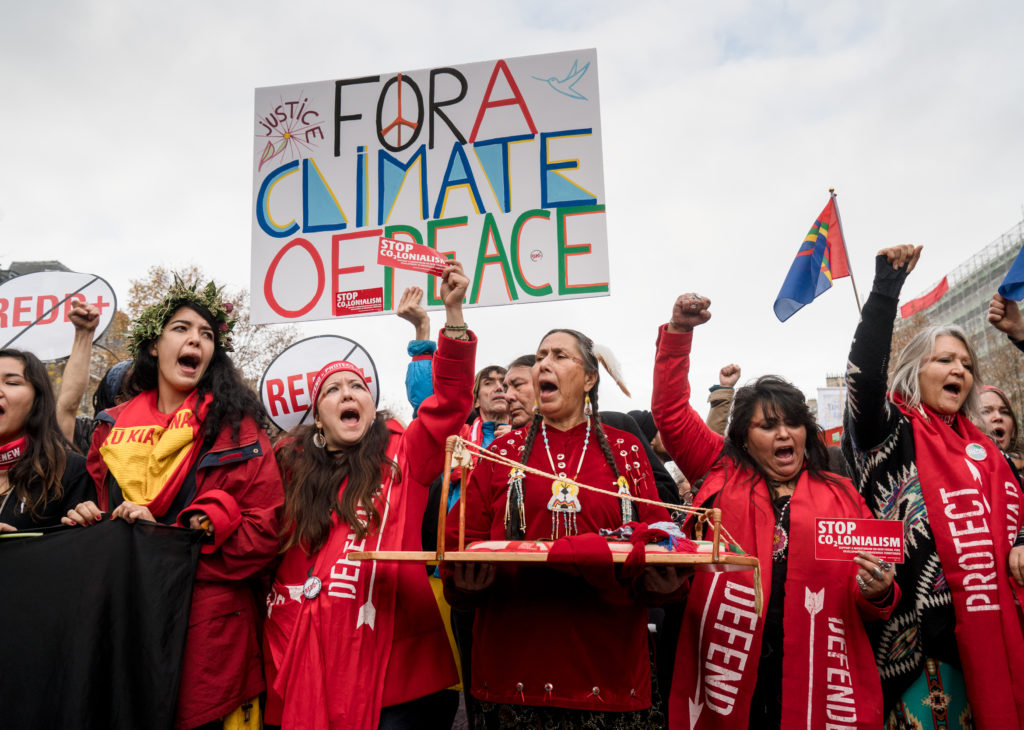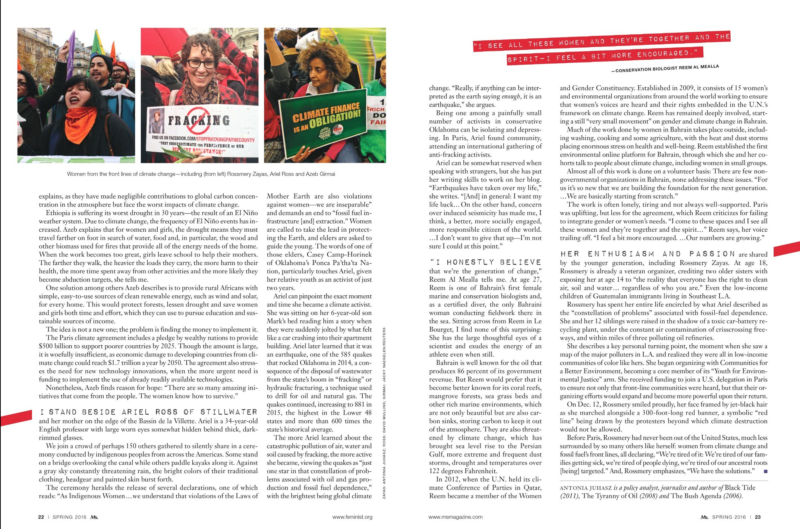Women Taking On Climate Change

 On Dec. 12, 2015, the Paris sky is alive with thousands of brightly painted signs: “Urgence Climatique!” (Climate Emergency!), “Le Pétrole Tue!” (Oil Kills!), “Keep Fossil Fuels in the Ground!”
On Dec. 12, 2015, the Paris sky is alive with thousands of brightly painted signs: “Urgence Climatique!” (Climate Emergency!), “Le Pétrole Tue!” (Oil Kills!), “Keep Fossil Fuels in the Ground!”
Despite a ban on protests in the wake of the November terrorist attacks, the signs are borne by a wave of 15,000 marchers filling the Avenue de la Grande Armée, the Arc de Triomphe towering behind. I walk next to a group of women of diverse ethnicities and ages, part of a delegation of front-line community activists from the United States. The march is joyous and boisterous, more street party than protest, as the sounds of drums, cheers and song fill the air.
“This is going to be a big moment in history,” a beaming 18-year-old, Rossmery Zayas of Southeast Los Angeles, tells me, tears welling in her eyes. “I’m so honored to be a part of it!”
Barely 10 miles away at Le Bourget conference center, representatives of 195 nations are exchanging handshakes and hugs as they sign the United Nations Paris climate agreement, the farthest-reaching global commitment to reduce carbon emissions to date. Yet this is not the history-making moment to which Rossmery refers.
Opinions vary on the overall success of the agreement, with those living on the front lines of fossil fuel operations and the climate crisis generally the most critical. Among the deficiencies is that it fails to mandate that all actions taken under the agreement be gender-responsive, undermining its very ability to solve the climate crisis. Though not from lack of trying. A coalition of women’s organizations from across the globe had come together early in the two-weeklong negotiating process for a final push to ensure that the rights of women be enshrined in the agreement.
But the language they supported—to “ensure gender equality” and require the “full and equal participation of women” in the implementation of the agreement—was ultimately moved from the operating text to the preamble, making it non-legally binding, more of an aspiration than a concrete commitment.
The agreement rests on individual climate plans submitted by each government and updated every five years. As nations implement these plans, however, none will be required to take into account the impacts on women—when, for example, setting goals or reporting outcomes or formulating national transportation and renewable-energy priorities. Nor are countries required to incorporate women’s unique contributions to solving the climate crisis. As Mary Robinson, the former U.N. human rights chief and Ireland’s first woman president, had warned days earlier, the negotiations were too dominated by men, to the detriment of effective action. She told the Guardian newspaper, “This is a very male world [at the conference]. When it is a male world, you have male priorities.”
The good news is that tens of thousands of women were in Paris—as activists, advocates, policy experts and protesters. Some sought to influence negotiators; all came to meet, strategize and build an unstoppable global movement for climate justice. It is this movement to which Rossmery was referring, for just 13 days earlier, more than half a million people took to the streets in 175 nations demanding immediate climate action. On Dec. 12, Rossmery and the other marchers in Paris celebrated all that this movement would achieve going forward.

I had the privilege of interviewing dozens of women in Paris, and I share four of their personal stories here: one from Africa, one from the Middle East, two from the United States; lifelong activists and newcomers. Fortunately for us, Paris is just one stop along their activist journeys.
“If you’re like me and you feel panicked about what to do,” instructs Ariel Ross of Stillwater, Oklahoma, “a good thing to do is find someone who is already doing something, and try to help.”
“Addressing the issue of climate change is directly addressing women’s issues,” Azeb Girmai of Ethiopia tells me. “[Energy access] is the game changer for women in Africa.”
As we sit inside Le Bourget conference center, Azeb is eager to speak, her smile both warm and hopeful. At 47, Azeb is the climate policy lead for LDC Watch International, a network of civil society organizations advocating on behalf of the 48 Least Developed Countries (LDCs) in the world, most of which are in Africa. She is here seeking to influence the decisions of some 15,000 government negotiators. The case is particularly crucial for LDCs, she explains, as they have made negligible contributions to global carbon concentration in the atmosphere but face the worst impacts of climate change.
Ethiopia is suffering its worst drought in 30 years—the result of an El Niño weather system. Due to climate change, the frequency of El Niño events has increased. Azeb explains that for women and girls, the drought means they must travel farther on foot in search of water, food and, in particular, the wood and other biomass used for fires that provide all of the energy needs of the home.
When the work becomes too great, girls leave school to help their mothers. The farther they walk, the heavier the loads they carry, the more harm to their health, the more time spent away from other activities and the more likely they become abduction targets, she tells me.
One solution among others Azeb describes is to provide rural Africans with simple, easy-to-use sources of clean renewable energy, such as wind and solar, for every home. This would protect forests, lessen drought and save women and girls both time and effort, which they can use to pursue education and sustainable sources of income.
The idea is not a new one; the problem is finding the money to implement it.
The Paris climate agreement includes a pledge by wealthy nations to provide $500 billion to support poorer countries by 2025. Though the amount is large, it is woefully insufficient, as economic damage to developing countries from climate change could reach $1.7 trillion a year by 2050. The agreement also stresses the need for new technology innovations, when the more urgent need is funding to implement the use of already readily available technologies.
Nonetheless, Azeb finds reason for hope: “There are so many amazing initiatives that come from the people. The women know how to survive.”
I stand beside Ariel Ross of Stillwater and her mother on the edge of the Bassin de la Villette. Ariel is a 34-year-old English professor with large worn eyes somewhat hidden behind thick, dark rimmed glasses.
We join a crowd of perhaps 150 others gathered to silently share in a ceremony conducted by indigenous peoples from across the Americas. Some stand on a bridge overlooking the canal while others paddle kayaks along it. Against a gray sky constantly threatening rain, the bright colors of their traditional clothing, headgear and painted skin burst forth. The ceremony heralds the release of several declarations, one of which reads: “As Indigenous Women…we understand that violations of the Laws of Mother Earth are also violations against women—we are inseparable” and demands an end to “fossil fuel infrastructure [and] extraction.” Women are called to take the lead in protecting the Earth, and elders are asked to guide the young. The words of one of those elders, Casey Camp-Horinek of Oklahoma’s Ponca Pa’tha’ta Nation, particularly touches Ariel, given her relative youth as an activist of just two years.
Ariel can pinpoint the exact moment and time she became a climate activist. She was sitting on her 6-year-old son Mark’s bed reading him a story when they were suddenly jolted by what felt like a car crashing into their apartment building. Ariel later learned that it was an earthquake, one of the 585 quakes that rocked Oklahoma in 2014, a consequence of the disposal of wastewater from the state’s boom in “fracking” or hydraulic fracturing, a technique used to drill for oil and natural gas. The quakes continued, increasing to 881 in 2015, the highest in the Lower 48 states and more than 600 times the state’s historical average.
The more Ariel learned about the catastrophic pollution of air, water and soil caused by fracking, the more active she became, viewing the quakes as “just one star in that constellation of problems associated with oil and gas production and fossil fuel dependence,” with the brightest being global climate change. “Really, if anything can be interpreted as the earth saying enough, it is an earthquake,” she argues.
Being one among a painfully small number of activists in conservative Oklahoma can be isolating and depressing. In Paris, Ariel found community, attending an international gathering of anti-fracking activists.
Ariel can be somewhat reserved when speaking with strangers, but she has put her writing skills to work on her blog. “Earthquakes have taken over my life,” she writes. “[And] in general: I want my life back…On the other hand, concern over induced seismicity has made me, I think, a better, more socially engaged, more responsible citizen of the world.…I don’t want to give that up—I’m not sure I could at this point.”
“I honestly believe that we’re the generation of change,” Reem Al Mealla tells me.
At age 27, Reem is one of Bahrain’s first female marine and conservation biologists and, as a certified diver, the only Bahraini woman conducting fieldwork there in the sea. Sitting across from Reem in Le Bourget, I find none of this surprising: She has the large thoughtful eyes of a scientist and exudes the energy of an athlete even when still.
Bahrain is well known for the oil that produces 86 percent of its government revenue. But Reem would prefer that it become better known for its coral reefs, mangrove forests, sea grass beds and other rich marine environments, which are not only beautiful but are also carbon sinks, storing carbon to keep it out of the atmosphere. They are also threatened by climate change, which has brought sea level rise to the Persian Gulf, more extreme and frequent dust storms, drought and temperatures over 122 degrees Fahrenheit.
In 2012, when the U.N. held its climate Conference of Parties in Qatar, Reem became a member of the Women and Gender Constituency. Established in 2009, it consists of 15 women’s and environmental organizations from around the world working to ensure that women’s voices are heard and their rights embedded in the U.N.’s framework on climate change. Reem has remained deeply involved, starting a still “very small movement” on gender and climate change in Bahrain.
Much of the work done by women in Bahrain takes place outside, including washing, cooking and some agriculture, with the heat and dust storms placing enormous stress on health and well-being. Reem established the first environmental online platform for Bahrain, through which she and her cohorts talk to people about climate change, including women in small groups.
Almost all of this work is done on a volunteer basis: There are few nongovernmental organizations in Bahrain, none addressing these issues. “For us it’s so new that we are building the foundation for the next generation…We are basically starting from scratch.”
The work is often lonely, tiring and not always well-supported. Paris was uplifting, but less for the agreement, which Reem criticizes for failing to integrate gender or women’s needs. “I come to these spaces and I see all these women and they’re together and the spirit…” Reem says, her voice trailing off. “I feel a bit more encouraged. …Our numbers are growing.”
Her enthusiasm and passion are shared by the younger generation, including Rossmery Zayas. At age 18, Rossmery is already a veteran organizer, crediting two older sisters with exposing her at age 14 to “the reality that everyone has the right to clean air, soil and water… regardless of who you are.” Even the low-income children of Guatemalan immigrants living in Southeast L.A.
Rossmery has spent her entire life encircled by what Ariel described as the “constellation of problems” associated with fossil-fuel dependence.
She and her 12 siblings were raised in the shadow of a toxic car-battery recycling plant, under the constant air contamination of crisscrossing freeways, and within miles of three polluting oil refineries.
She describes a key personal turning point, the moment when she saw a map of the major polluters in L.A. and realized they were all in low-income communities of color like hers. She began organizing with Communities for a Better Environment, becoming a core member of its “Youth for Environmental Justice” arm. She received funding to join a U.S. delegation in Paris to ensure not only that front-line communities were heard, but that their organizing efforts would expand and become more powerful upon their return.
On Dec. 12, Rossmery smiled proudly, her face framed by jet-black hair as she marched alongside a 300-foot-long red banner, a symbolic “red line” being drawn by the protesters, beyond which climate destruction would not be allowed.
Before Paris, Rossmery had never been out of the United States, much less surrounded by so many others like herself: women from climate change and fossil fuel’s front lines, all declaring, “We’re tired of it: We’re tired of our families getting sick, we’re tired of people dying, we’re tired of our ancestral roots [being] targeted.” And, Rossmery emphasizes, “We have the solutions.”


